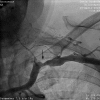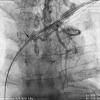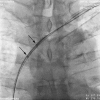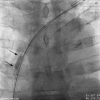Balloon venoplasty opens the road for an implantable defibrillator patient with complex stenosis
- PMID: 28680596
- PMCID: PMC5494389
- DOI: 10.1002/ccr3.1002
Balloon venoplasty opens the road for an implantable defibrillator patient with complex stenosis
Abstract
There is an increasing need for physicians to handle venous obstructions in pacemaker/implantable cardioverter-defibrillator implants. Venoplasty performed by an experienced operator is a simple, safe, and fast way to manage this situation and proceed to implant. Compared to other approaches, this strategy may offer particular advantages.
Keywords: Balloon; implantable cardioverter–defibrillator; pacemaker lead; venoplasty; venous occlusion; venous stenosis.
Figures
Similar articles
-
Left Subclavian and Innominate Vein Balloon Venoplasty Followed by Permanent Pacemaker Implantation: A Case Report.J Innov Card Rhythm Manag. 2019 Jul 15;10(7):3738-3742. doi: 10.19102/icrm.2019.100704. eCollection 2019 Jul. J Innov Card Rhythm Manag. 2019. PMID: 32494420 Free PMC article.
-
Subclavian balloon venoplasty to facilitate lead implant in patient with subclavian venous obstruction.J Invasive Cardiol. 2011 Apr;23(4):E83-5. J Invasive Cardiol. 2011. PMID: 21474859
-
Proposed strategies to overcome venous occlusion in the implantation of a cardiac implantable electronic device: A case report and literature review.Front Cardiovasc Med. 2022 Oct 24;9:1005596. doi: 10.3389/fcvm.2022.1005596. eCollection 2022. Front Cardiovasc Med. 2022. PMID: 36352849 Free PMC article.
-
Venous System Interventions for Device Implantation.Card Electrophysiol Clin. 2018 Mar;10(1):163-177. doi: 10.1016/j.ccep.2017.11.017. Card Electrophysiol Clin. 2018. PMID: 29428138 Review.
-
Subcutaneous implantable cardioverter defibrillator indication in prevention of sudden cardiac death in difficult clinical situations: A French expert position paper.Arch Cardiovasc Dis. 2020 May;113(5):359-366. doi: 10.1016/j.acvd.2020.03.011. Epub 2020 Apr 22. Arch Cardiovasc Dis. 2020. PMID: 32334981 Review.
References
-
- Mond, H. G. , and Proclemer A.. 2011. The 11th world survey of cardiac pacing and implantable cardioverter‐defibrillators: calendar year 2009–a world society of Arrhythmia's project. Pacing Clin. Electrophysiol. 34:1013–1027. - PubMed
-
- Kleemann, T. , Becker T., Doenges K., Vater M., Senges J., Schneider S., et al. 2007. Annual rate of transvenous defibrillation lead defects in implantable cardioverter‐defibrillators over a period of >10 years. Circulation 115:2474–2480. - PubMed
-
- Lickfett, L. , Bitzen A., Arepally A., Nasir K., Wolpert C., Jeong K. M., et al. 2004. Incidence of venous obstruction following insertion of an implantable cardioverter defibrillator. A study of systematic contrast venography on patients presenting for their first elective ICD generator replacement. Europace 6:25–31. - PubMed
-
- Santini, M. , Di Fusco S. A., Santini A., Magris B., Pignalberi C., Aquilani S., et al. 2016. Prevalence and predictor factors of severe venous obstruction after cardiovascular electronic device implantation. Europace 18:1220–1226. - PubMed
-
- Riley, R. F. , Petersen S. E., Ferguson J. D., and Bashir Y.. 2010. Managing superior vena cava syndrome as a complication of pacemaker implantation: a pooled analysis of clinical practice. Pacing Clin. Electrophysiol. 33:420–425. - PubMed
Publication types
LinkOut - more resources
Full Text Sources
Other Literature Sources





